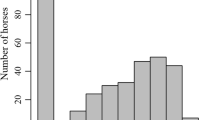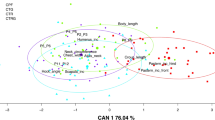Abstract
Genetic analyses in donkeys are likely to face compromises in terms of sample size and population structure. This study aims at implementing a suitable model to estimate breeding values and genetic parameters for gaits in Andalusian donkeys. Empirical observation revealed that ambling donkeys (showing a slightly uneven, non-isochronous 1–2, 3–4 lateral sequence gait) did not walk (i.e. presented an isochronous, even 1-2-3-4 sequence gait) and vice versa. However, the two donkey groups could trot, equally. In this study, 2700 gait records were registered from 300 donkeys. The sample included 1350 gait records from 169 ambling/trotting donkeys and 1350 gait records from 131 walking/trotting donkeys. Fixed effects included year, season, sex, farm/owner, husbandry system, weather, ground type and appraisers. Weight and age were included as covariates. MTDFREML software was used to estimate (co)variance components, genetic parameters and predict breeding values and their accuracies in both sets, separately. Gaits’ heritability ± SE estimates were 0.56 ± 0.155, 0.53 ± 0.317 and 0.67 ± 0.166 for amble, walk and trot, respectively. Genetic correlations were 0.31 ± 0.216, 0.42 ± 0.115 and 0.28 ± 0.178, for amble and walk, amble and trot and walk and trot, respectively. Not all gaits are suitable to treat every human sensomotor condition. We developed a locomotion selection index, assessing the relative loss/gain in index accuracy when each gait modality was excluded to develop different gait specific therapeutic lines to genetically select the best performing donkeys from each gait modality. Our results suggest that gait genetic lines could be developed and may be potential selection criteria to consider in assisted-therapy donkey breeding programs.

Similar content being viewed by others

References
Alkhateeb-Shehada H (2008) Donkeys and Mules in Arabic Veterinary Sources from the Mamlūk Period (7th–10th/13th–16th Century). Al-Masāq 20:207–214
Andersson LS, Larhammar M, Memic F, Wootz H, Schwochow D, Rubin C-J, Patra K, Arnason T, Wellbring L, Hjalm G, Imsland F, Petersen JL, McCue ME, Mickelson JR, Cothran G, Ahituv N, Roepstorff L, Mikko S, Vallstedt A, Lindgren G, Andersson L, Kullander K (2012) Mutations in DMRT3 affect locomotion in horses and spinal circuit function in mice. Nature 488:642–646
Boldman KG, Kriese LA, van Vleck L, van Tassell D, Kachman SD (1995) A Manual for Use of MTDFREML. A Set of Programs to Obtain Estimates of Variances and Covariances. US Department of Agriculture, Agricultural Research Service, Washington, DC
Cameron N (1997) Selection indices and prediction of genetic merit in animal breeding. CAB International, Wallingford
Delgado JV, Navas FJ, Miranda JC, Miró M, Arando A, Pizarro MG (2014) Preliminary Body Weight Estimation Methodology and its Applicaction to the Andalusian Donkey Breed as an Energetic Producer. AICA 4:207–209
Ducro BJ, Koenen EPC, van Tartwijk JMFM., Bovenhuis H (2007) Genetic relations of movement and free-jumping traits with dressage and show-jumping performance in competition of Dutch Warmblood horses. Livest Sci 107:227–234
Gerber Olsson E, Árnason T, Näsholm A, Philipsson J (2000) Genetic parameters for traits at performance test of stallions and correlations with traits at progeny tests in Swedish warmblood horses. Livest Prod Sci 65:81–89
Gómez M, Gama L, León J, Fernández J, Attalla S, Delgado J (2016) Genetic parameters for harmony and gaits in Hispano-Arabe horses estimated by Bayesian methods and restricted maximum likelihood. Livest Sci 188:159–165
Haberland AM, König von Borstel U, Simianer H, König S (2012) Integration of genomic information into sport horse breeding programs for optimization of accuracy of selection. animal 6: 1369–1376
IBM, Corp (2016) IBM SPSS statistics for windows. IBM Corp., Armonk
Navas FJ, Delgado JV (2016) Ambling and walk gaits preliminary characterization and therapeutic application in donkeys, X Iberian Congress on animal genetical resources, 17th September. Castelo Branco, Portugal th- (Sociedade Portuguesa de Recursos Genéticos Animais (SPREGA)/Sociedad Española para los Recursos Genéticos Animales (SERGA)
Navas FJ, Delgado JV, Vargas J (2016) Current donkey production and functionality: Relationships with humans. Book 1. UcoPress, Córdoba
Navas FJ, Jordana J, León JM, Barba C, Delgado JV (2017) A model to infer the demographic structure evolution of endangered donkey populations. animal: 1–10
Okada K (2013) Is omega squared less biased? a comparison of three major effect size indices in one-way ANOVA. Behaviormetrika 40:129–147
Porter V, Alderson L, Hall SJG, Sponenberg DP (2016) Mason’s world encyclopedia of livestock breeds and breeding, 2 volume pack. CABI, Oxfordshire
Rustin M, Janssens S, Buys N, Gengler N (2009) Multi-trait animal model estimation of genetic parameters for linear type and gait traits in the Belgian warmblood horse. J Anim Breed Genet 126:378–386
Schroderus E, Ojala M (2010) Estimates of genetic parameters for conformation measures and scores in Finnhorse and Standardbred foals. J Anim Breed Genet 127:395–403
Suontama M, van der Werf JHJ, Juga J, Ojala M (2013) Genetic correlations for foal and studbook traits with racing traits and implications for selection strategies in the Finnhorse and Standardbred trotter. J Anim Breed Genet 130:178–189
The MathWorks, Inc (2015) ‘MATLAB’ release R2015a. Natick
Uchiyama H, Ohtani N, Ohta M (2011) Three-dimensional analysis of horse and human gaits in therapeutic riding. Appl Anim Behav Sci 135:271–276
Van Vleck LD (1993) Selection index and introduction to mixed model methods. CRC Press/Taylor and Francis, London
Vicente AA, Carolino N, Ralão-Duarte J, Gama LT (2014a) Selection for morphology, gaits and functional traits in Lusitano horses: I. Genetic parameter estimates. Livest Sci 164:1–12
Vicente AA, Carolino N, Ralão-Duarte J, Gama LT (2014b) Selection for morphology, gaits and functional traits in Lusitano horses: II. Fixed effects, genetic trends and selection in retrospect. Livest Sci 164:13–25
Voznesenskiy S, Rivera-Quinatoa JA, Bonilla-Yacelga KA, Cedeño-Zamora MN (2016) Do equine-assisted physical activities help to develop gross motor skills in children with the down syndrome? Short-term results. Procedia Soc Behav Sci 233:307–312
Author information
Authors and Affiliations
Corresponding author
Ethics declarations
Conflict of interest
The authors declare that they have no conflict of interest.
Rights and permissions
About this article
Cite this article
Navas González, F.J., Jordana Vidal, J., León Jurado, J.M. et al. Genetic parameter estimation and implementation of the genetic evaluation for gaits in a breeding program for assisted-therapy in donkeys. Vet Res Commun 42, 101–110 (2018). https://doi.org/10.1007/s11259-018-9712-6
Received:
Accepted:
Published:
Issue Date:
DOI: https://doi.org/10.1007/s11259-018-9712-6



